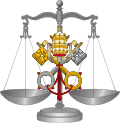Age and manuscript tradition
Hib is one of the oldest systematic canon law collections in Europe. It was compiled in Ireland between 669 and 748. Its compilers are believed to have been Cú Chuimne of Iona (†747) and Ruben of Dairinis (†725). [1] The attribution of Hib to these two men is problematical, however, because it is based solely on a garbled colophon found in a ninth-century manuscript from Brittany with a Corbie and Saint-Germain provenance (now in Paris, Bibliothèque nationale, Lat. 12021). [2] The earliest manuscript witness, according to Rob Meens of Utrecht University, is an early eighth-century collection preserved in Copenhagen (KB 58); Meens in fact refers to the manuscript as a "forerunner" of the Hibernensis. [3] Several recensions of the collection may have circulated in the early Middle Ages, but the two main recensions (called A and B), containing between 65 and 69 books (the division of books varies between manuscripts), seem to date from an early stage of the collection's circulation. Hib circulated widely on the Continent in the eighth and ninth centuries, particularly in Brittany, [4] and had a particularly strong influence on Italian canonistic thought after the ninth century. [5] It may have played a role in the anointment of Pepin the Short as king of Francia in 751, on the advice of Vergilius of Salzburg. [6]
Contents
Beyond topics typically covered by canon law collections, Hib touches on prayer, consecrated places, martyrs, the ‘substances of men’, blessings, and the soul; indeed, certain chapters often verge on essays on morality. Maurice P. Sheehy said of Hib, ‘as a single document, [it] is probably the most ambitious endeavour to codify Christian life of all the medieval canonical compilations.’ [7] A relatively small portion of the work comprises excerpts from ancient canons and decretals; far more common are citations of Scripture and the Church Fathers―Origen, Jerome, Augustine, Pope Gregory I, and Gregory Nazianzenus being most prominent among these. Its use of Greek Fathers as sources for canon law has been called ‘unique’. [8] Not including quotations inside excerpted patristic writers, Hib contains about 1,000 quotations of Scripture, two-thirds of which come from the Old Testament. [9]
Thomas Charles-Edwards considered the methods by which the compiler(s) of this collection organized their material: "the Hibernensis both contains and relies on exegesis to a far greater extent than do such collections as those of Dionysius Exiguus". [10] The compiler, or ‘exegete’ as Charles-Edwards calls him, was interested not only in presenting decisions, but in finding answers to questions on morality; it was the compiler’s own moral preoccupations, as well as his own interpretation of his sources that determined the shape and content of the collection. [11] The compiler’s use of testimonia and exempla to prove a rule sometimes led him to take a ‘dialectical’ approach to legal questions, in which he would present opposing rules on a single topic and attempt some sort of crude reconciliation, though usually this reconciliation is only ever implied. For some scholars, this has qualified Hib as something of a summa discordantium. [12]
The exegetical and essaic qualities of Hib were signalled by Gabriel le Bras when he argued that Hib is ‘more than a canonical collection, but a repository of scriptural and patristic texts on discipline, which the author accepted as the principal sources of the law. This characteristic of the Hibernensis quite naturally results in its embracing a much wider domain than the other collections: not only the entire domain of the ecclesiastical institution, but also the realm of the social and spiritual life.’
Hib was not the only form of law available in medieval Ireland. A secular law, more commonly known as the Brehon Laws, existed and is often at variance with Hib, although perhaps more surprising is their tendency to overlap.

